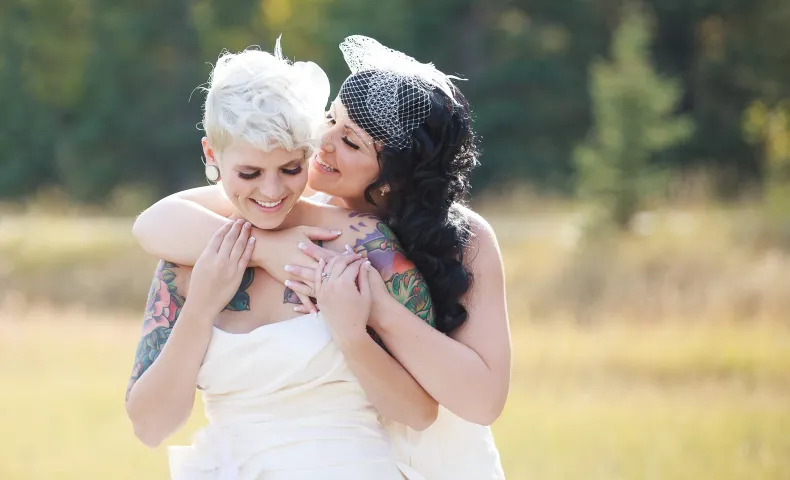 Photo by Lisa Redfern
Photo by Lisa Redfern
Celebrating The Gains Of Underdog LGBT Groups
This blog post originally appeared in the Huffington Post on June 30, 2011.
In the days after California voters approved Proposition 8 in 2008, the measure that stripped away from gay and lesbian couples the freedom to marry, people began talking about how progress had stalled, and how the organizations that were supposed to be advancing the cause of LGBT rights had become ineffectual.
As we celebrate the New York marriage vote and the 42nd anniversary of the Stonewall Riots, it’s time to take real pride in the LGBT organizations that do us proud every day of the year. Working together, this valiant group of underfunded, overwhelmed and scrappy organizations and their leaders, staff and volunteers has delivered (and continues to deliver) historic gains for LGBT people across the country.
Let’s start with some facts. By any objective measure, the LGBT movement has made extraordinary progress in a short period of time. In just the last 10 years:
- The number of states (including the District of Columbia) protecting lesbian, gay and bisexual people from discrimination almost doubled to 22, and these states cover 44 percent of the U.S. population.
- The number of states (including the District of Columbia) extending marriage equality or “all-but-marriage” rights to same-sex couples grew from just one to 14 (including three more this year), and these states cover 36 percent of the U.S. population.
- The number of states (including the District of Columbia) protecting transgender people from discrimination jumped from one to 16 (including three more this year), and these states cover 29 percent of the U.S. population.
- Anti-gay policies going back hundreds of years have been repealed in four of the five leading mainline Protestant denominations (including the Presbyterian Church USA in May).
These broad gains don’t begin to tell the whole story. If you look at what’s been happening in towns and cities and among American businesses on these issues over the past decade, you also see the LGBT-rights cause advancing by leaps and bounds. The number of gay student alliances in U.S. high schools has surged to nearly 5,000, we’re seeing more and more LGBT-inclusive safe schools laws, and nine out of ten Fortune 500 companies have adopted nondiscrimination policies protecting their gay employees. The list of achievements goes on and on. And, we’re not done yet: All polling data show that public support for LGBT equality is not leveling off but accelerating.
What makes this ongoing progress even more remarkable is that the LGBT-rights movement has been outnumbered and outfunded at virtually every turn and in every arena, even in comparison to other progressive movements. Opponents of LGBT rights operate hundreds of radio stations, they run huge (and hugely influential) national advocacy organizations, and they are enmeshed in enormous faith communities and able to deliver their anti-equality message to millions every weekend.
While opponents of LGBT rights have at least eight national advocacy organizations with budgets of more than $10 million, the LGBT movement has just one. In fact, the annual budget of just one of the biggest opponents of LGBT rights, Focus on the Family/CitizenLink, is greater than the budgets of the 39 largest LGBT advocacy, legal and research organizations, combined.
So what explains the continued traction that the LGBT movement has enjoyed in the face of such adversity? There are a lot of related factors. For example, more LGBT people are coming out and more non-LGBT people are getting to know them and are themselves becoming advocates for equal rights. There is also the influence of popular culture and celebrities, the high profile of LGBT issues in the media, and the vibrant presence of LGBT bloggers in social media.
But the legal and policy advances of the last decade did not spring miraculously from the results of a public opinion poll or a single heartfelt, pro-gay acceptance speech at the Oscars. Instead, they happened because LGBT organizations made them happen. Whether working for high-profile victories such as the marriage equality win in New York last week or defending an LGBT-inclusive nondiscrimination ordinance from being overturned by voters in Bowling Green, Ohio, these organizations provide focus, deploy volunteers, organize phone banks, and wrangle allies.
At the Evelyn and Walter Haas, Jr. Fund, we have been privileged to support a variety of LGBT organizations at the national, state and local levels. They range from the Palm Center at UCLA, whose research helped make the case for overturning the U.S. military’s “Don’t Ask, Don’t Tell” policy, to Equality North Carolina, the driving force behind the first LGBT-inclusive safe schools law in the South. Organizations like these are working every day, often against considerable odds, to keep the cause of LGBT rights moving forward, and to prevent the movement’s opponents from keeping our society and our communities mired in an unequal past.
Has the LGBT rights movement done everything it needs to do? Not by a long shot. Could it be doing certain things more effectively? Of course. But as Pride celebrations take place around the globe this summer, I encourage everyone who supports LGBT rights to take a stand for pride—in the organizations that drive our movement and the people behind them.